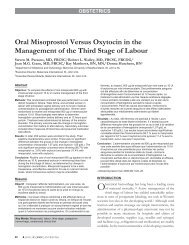The DSM Diagnostic Criteria for Hypoactive Sexual Desire Disorder ...
The DSM Diagnostic Criteria for Hypoactive Sexual Desire Disorder ...
The DSM Diagnostic Criteria for Hypoactive Sexual Desire Disorder ...
You also want an ePaper? Increase the reach of your titles
YUMPU automatically turns print PDFs into web optimized ePapers that Google loves.
Arch Sex Behav<br />
Table 1 continued<br />
Method of assessment Distress measured Prevalence<br />
Study Sample characteristics Country Age In a sexual<br />
relationship<br />
Using a FSFI cut-off score of 3.16,<br />
55% had low desire. Using a<br />
FSDS cut-off score of 8.75, 23%<br />
had low desire and distress<br />
Female <strong>Sexual</strong> Distress<br />
Scale<br />
Questionnaire<br />
completion<br />
5,463 women Finland 18–49 Must have engaged in<br />
sexual activity<br />
with a partner over<br />
the past 4 weeks<br />
Witting et al.<br />
(2008)<br />
34% had low desire, overall 10%<br />
had low desire and distress<br />
Female <strong>Sexual</strong> Distress<br />
Scale<br />
United States 18–102 Not necessary Questionnaires: <strong>Sexual</strong><br />
desire assessed with<br />
one question: ‘‘How<br />
often do you desire to<br />
engage in sexual<br />
activity?’’<br />
13,581 women<br />
PRESIDE<br />
Shifren et al.<br />
(2008)<br />
10.7% reported lack of desire <strong>for</strong><br />
6 months or more. 27.9% of those<br />
sought help<br />
Distress not assessed but<br />
treatment seeking was<br />
6,942 women Britain 16–44 Not necessary Computer-assisted<br />
personal interview.<br />
<strong>Desire</strong> assessed with<br />
‘‘In the last year, have<br />
you experienced a lack<br />
of interest in having<br />
sex <strong>for</strong> six months or<br />
longer?’’<br />
Mitchell et al.<br />
(2009)<br />
of using fantasy and overall higher levels of sexual desire and<br />
motivation (Hurlbert, Apt, Hurlbert, & Pierce, 2000).<br />
It is clear that partner influences on women’s sexual desire<br />
are relevant to the diagnosis of sexual desire disorder. However,<br />
the <strong>DSM</strong>s instruction that the clinician’s judgment guide the<br />
assessment of whether relationship duration affects the sexual<br />
dysfunction provides little guidance <strong>for</strong> making a diagnosis.<br />
Consider the situation in which a woman desires sexual activity<br />
once/month and her partner desires it twice/daily. <strong>The</strong> couple<br />
may present <strong>for</strong> treatment with the initial complaint of her low<br />
sexual desire. However, this is a case of desire discrepancy <strong>for</strong><br />
the woman’s low desire is only relative to her partner’s somewhat<br />
higher desire. Another illustrative situation is the case of<br />
the woman who does not desire sexual activity from a partner<br />
who is physically and/or emotionally abusive towards her. In<br />
both of these scenarios, appreciating the relational influences<br />
may change the decision as to whether a diagnosis of low desire<br />
is given. One means of capturing the relational component may<br />
be with a dimensional criterion, as was proposed in the assessment<br />
of distress. Such a ‘‘relational influences’’ specifier would<br />
capture, on a Likert scale, the extent to which relationshiprelated<br />
factors may be implicated in the etiology or maintenance<br />
of the woman’s low desire. This may be quantified with (0) no,<br />
(1)mild,(2)moderate,and(3)extreme relationalinfluences.Itis<br />
obvious that the reliability and validity of this added dimensional<br />
criterion would require empirical justification in field<br />
trials. Thus, the woman <strong>for</strong> whom a lack of sexual desire is<br />
completely attributed to partner-related factors would still meet<br />
criteria <strong>for</strong> a desire disorder; however, the clinical recommendations<br />
may direct a treatment that is more oriented towards the<br />
couple-level dysfunction if her relational influences score was<br />
higher. This proposal is similar to the adoption of a relational<br />
contextual descriptor from the 2003 Consensus committee<br />
(Basson et al., 2003).<br />
<strong>The</strong> Judgment of Deficiency is Determined<br />
by the Clinician<br />
Criterion A of HSDD in the <strong>DSM</strong>-IV-TR (American Psychiatric<br />
Association, 2000) states that ‘‘<strong>The</strong> judgment of deficiency<br />
or absence is made by the clinician, taking into account factors<br />
that affect sexual functioning, such as age and the context of the<br />
person’s life.’’ Although this statement lacks any recommendation<br />
about how ‘‘judgment’’ is made, the qualities of the clinician<br />
inmaking the judgment,andwhether judgment possesses<br />
validity andinter-rater reliability, this statement does emphasize<br />
the contextual (and relational) factors that may influence a<br />
woman’s low desire. Similarly, the International Classification<br />
Committee also recommended that ‘‘<strong>The</strong> lack of interest is<br />
considered to be beyond a normative lessening with life cycle<br />
and relationship duration’’ (Basson et al., 2003). It has been<br />
established that sexual intercourse frequency declines with relationshipduration(e.g.,Christopher&Sprecher,2000;<br />
Klusmann,<br />
123

















